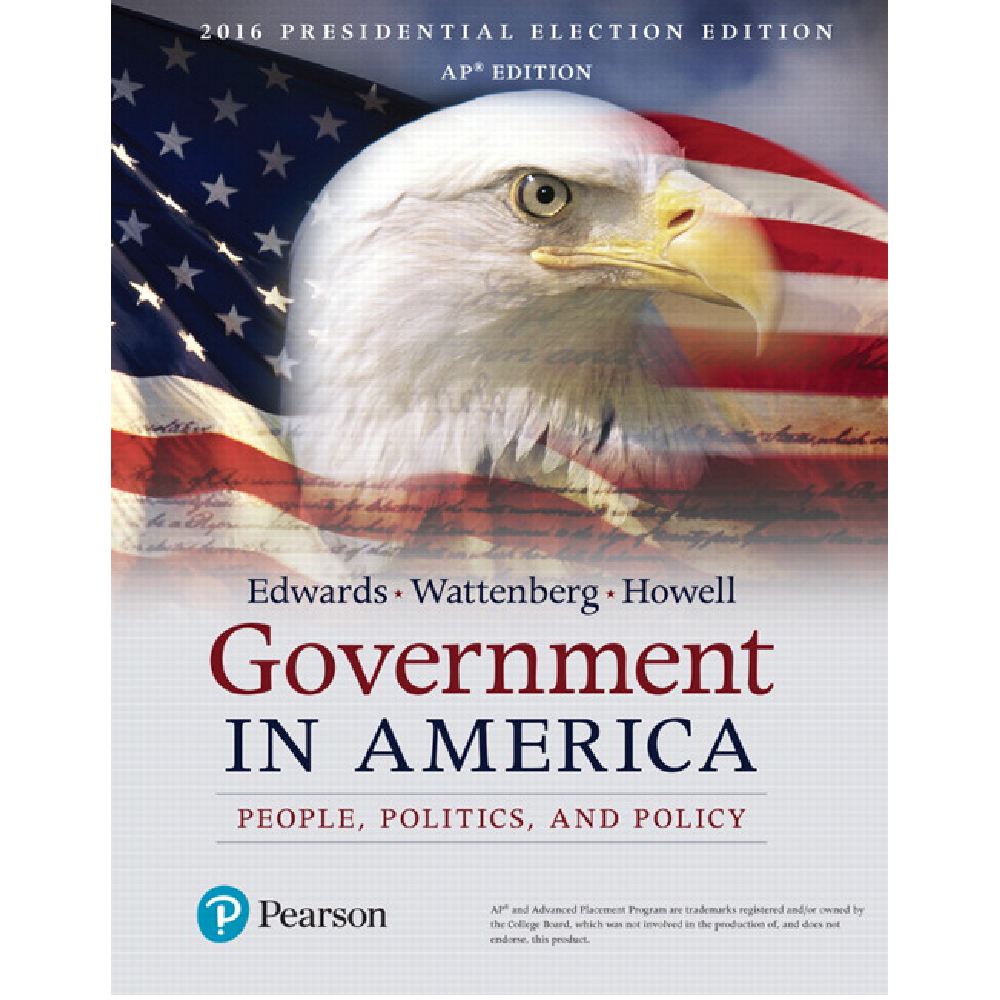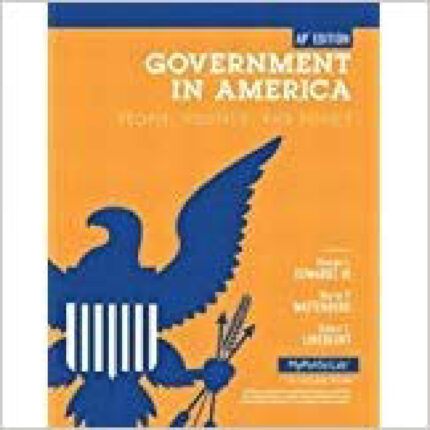Government in America People, Politics, And Policy 2016 Presidential Election 17th Edition By George C – Test Bank
The Budget: The Politics of Taxing and Spending
Multiple-Choice Questions
1. Which president had low budget deficits during his presidency?
a. Ronald Reagan
b. Barack Obama — Consider This: While Obama has worked to curb spending, it was another Democratic president that had the low deficits throughout his time in office.
c. Bill Clinton
d. George H. W. Bush
Answer: c
Test Bank Item Title: TB_Q13.1.1
Topic: Introduction; Federal Revenue and Borrowing
Learning Objective: Introduction; LO 13.1: Describe the sources of funding for the federal government and assess the consequences of tax expenditures and borrowing.
Page Reference: 402
Skill Level: Remember the Facts
Difficulty Level: Easy
2. According to Figure 13.3, what is the approximate amount of the national debt in 2015?
a. $17.5 trillion
b. $3.7 trillion — Consider This: While this number is high, the actual national debt in 2015 was even higher.
c. $800 billion
d. $500 billion
Answer: a
Test Bank Item Title: TB_Q13.1.2
Topic: Federal Revenue and Borrowing
Learning Objective: LO 13.1: Describe the sources of funding for the federal government and assess the consequences of tax expenditures and borrowing.
Page Reference: 387
Skill Level: Remember the Facts
Difficulty Level: Easy
3. Tax expenditures are __________.
a. yearly appropriations of funds by the president and Congress — Consider This: While these may seem like expenditures, in the language of government funding, these deal with specific types of losses.
b. revenue losses from special exemptions, exclusions, or deductions
c. the financial resources of the government
d. federal policies allocating tax burdens and benefits
Answer: b
Test Bank Item Title: TB_Q13.1.3
Topic: Federal Revenue and Borrowing
Learning Objective: LO 13.1: Describe the sources of funding for the federal government and assess the consequences of tax expenditures and borrowing.
Page Reference: 388-389
Skill Level: Understand the Concepts
Difficulty Level: Moderate
4. The Social Security Act was enacted in __________.
a. 1865
b. 1890
c. 1935
d. 1964 — Consider This: While social spending increased in 1964 under President Johnson, Social Security emerged in the wake of the Great Depression.
Answer: c
Test Bank Item Title: TB_Q13.2.4
Topic: Federal Expenditures
Learning Objective: LO 13.2: Analyze federal expenditures and the growth of the budget.
Page Reference: 392
Skill Level: Remember the Facts
Difficulty Level: Easy
5. Which is the largest social policy of the federal government?
a. Social Security
b. drug rehabilitation
c. assistance for the poor — Consider This: Significant resources are devoted to assisting those in need, but another area is the largest social policy for the federal government.
d. food subsidies
Answer: a
Test Bank Item Title: TB_Q13.2.5
Topic: Federal Expenditures
Learning Objective: LO 13.2: Analyze federal expenditures and the growth of the budget.
Page Reference: 394
Skill Level: Remember the Facts
Difficulty Level: Easy
6. The __________ Amendment permits Congress to levy income taxes.
a. Sixteenth
b. Seventeenth [This Amendment does not relate to income taxes, but it was added to the Constitution in the same era as the right answer.
c. Eighteenth
d. Nineteenth
Answer: a
Test Bank Item Title: TB_Q13.1.6
Topic: Federal Revenue and Borrowing
Learning Objective: LO 13.1: Describe the sources of funding for the federal government and assess the consequences of tax expenditures and borrowing.
Page Reference: 384
Skill Level: Remember the Facts
Difficulty Level: Easy
7. Which of the following budgetary process actors does the president oversee?
a. House and Ways Committee
b. Joint Committee on Taxation
c. Congressional Budget Office — Consider This: Rather than being overseen by the president, the CBO reports and responds to members of Congress and their committees.
d. Office of Management and Budget
Answer: d
Test Bank Item Title: TB_Q13.3.7
Topic: The Budgetary Process
Learning Objective: LO 13.3: Outline the budgetary process and explain the role that politics plays.
Page Reference: 400
Skill Level: Understand the Concepts
Difficulty Level: Moderate
8. By law, the president must submit a budget by the first Monday in __________.
a. February
b. September
c. October — Consider This: The budget cycle ends in October, but begins during the winter.
d. November
Answer: a
Test Bank Item Title: TB_Q13.3.8
Topic: The Budgetary Process
Learning Objective: LO 13.3: Outline the budgetary process and explain the role that politics plays.
Page Reference: 400
Skill Level: Remember the Facts
Difficulty Level: Easy
9. In which of the following years was Medicare added to the Social Security system?
a. 1935
b. 1965
c. 1998 — Consider This: Medicare was added during the Johnson Presidency—not three decades later under President Clinton.
d. 2001
Answer: b
Test Bank Item Title: TB_Q13.2.9
Topic: Federal Expenditures
Learning Objective: LO 13.2: Analyze federal expenditures and the growth of the budget.
Page Reference: 393
Skill Level: Remember the Facts
Difficulty Level: Easy
10. In which of the following years were prescription drug benefits added to Medicare?
a. 1965 — Consider This: While Medicare came into existence in 1965, prescription drugs were not added until the 21st Century.
b. 1974
c. 2003
d. 2012
Answer: c
Test Bank Item Title: TB_Q13.2.10
Topic: Federal Expenditures
Learning Objective: LO 13.2: Analyze federal expenditures and the growth of the budget.
Page Reference: 393













Reviews
There are no reviews yet.